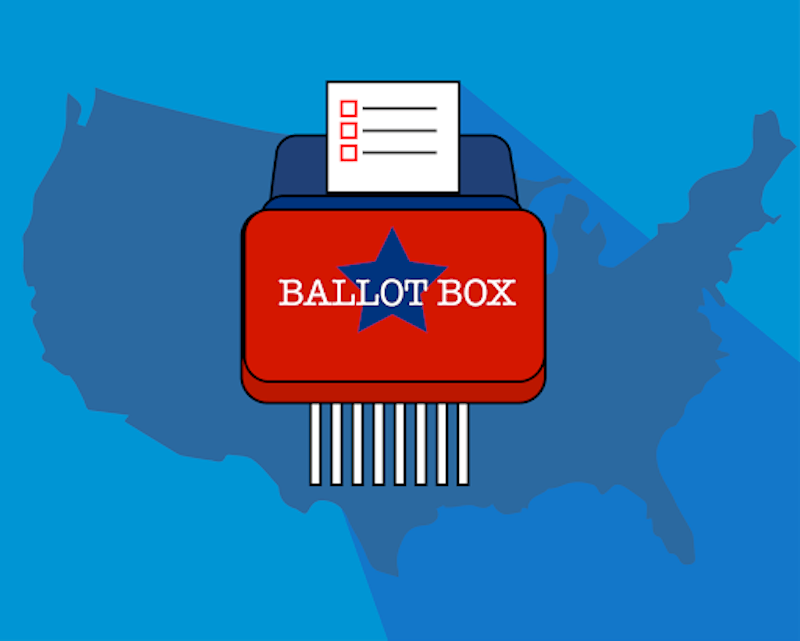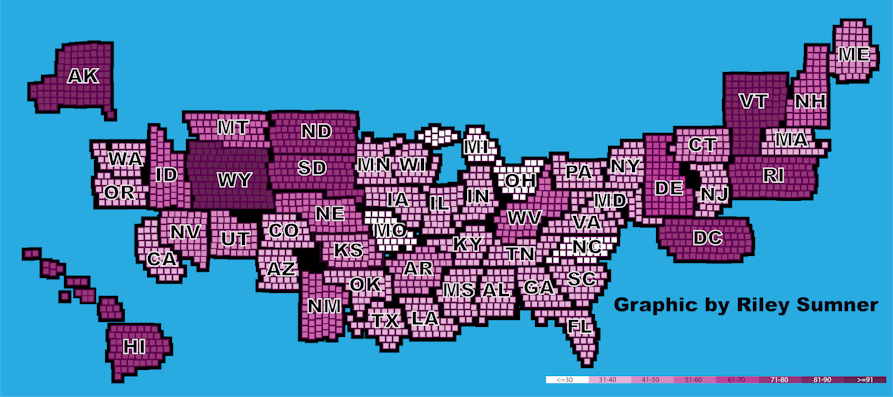

Wisconsin held its primaries on Tuesday following two court decisions blocking Governor Evers’s executive orders to postpone the contest and expand mail-in options.
The Wisconsin State Supreme Court ruled that Evers could not postpone the election, and the U.S. Supreme Court ruled all ballots must still be postmarked by the date of the election.
Both decisions put the health and safety of Wisconsinites in serious danger, but justified the decisions by suggesting a need to maintain the current rules of the election in order to protect future elections.
If the goal is to protect a system that endangers people for voting, the system is broken. U.S. election processes have been broken for a long time and these partisan rulings should make us rethink how we elect our country’s leaders.
The fundamental assumption when it comes to voting protocol should be as follows: everyone who is legally able to vote should be able to do so as easily as possible.
Making it easier to vote is one pillar used to support increased voter turnout. There are a number of laws that are disguised as “election security” laws, but ultimately work to decrease voter turnout. The most common example of this is voter ID requirements.
Voter ID is branded as an effective form of identification that verifies a person's eligibility to vote. Instead, it makes the process to become eligible longer and often blocks people who would otherwise be eligible to vote.
Systems vary between states, but generally a person is required to first register a number of days in advance of the election and second, produce one or multiple forms of additional identification.
According to a study conducted by Michael Sivak and Brandon Schoettle at the University of Michigan Transportation Research Institute, the number of people getting their driver's licenses each year is decreasing. If this piece of information is required, it means less people become eligible to vote.
The forms of identification a state allows seem to indicate which groups of people it wants voting. Texas, for example, allows a Handgun License to be used as a valid form of ID but doesn’t allow a university-issued ID.
If the goal of extra ID forms is to verify citizenship, none of these documents do so on their own.
Same Day Registration is also associated with higher turnout, according to Data For Progress. If people are forced to register in advance and endure a complicated registration system, people may instead decide not to vote.
But then let’s think about the logic of someone actually committing voter fraud. Aside from the fact that there is no evidence to support the existence of widespread voter fraud, many public officials who support voter ID seem to argue that it’s a problem for the country.
In order to commit voter fraud, a person would have to believe that an additional vote would have a significant impact on the outcome of the election. Even the extremely close state-wide elections are generally over 1,000 votes apart, so mobilizing enough people to vote illegally to change the outcome of an election is just absurd.
This is not to mention the severe penalties somebody would face if convicted with voter impersonation, which can result in fines, prison time and disenfranchisement.
To conclude: voter fraud is an irrational crime. Voter ID laws exist not to protect the integrity of our elections, but instead block people from voting.
Beyond getting to the polls, the next question is who should be allowed to vote?
Richard v. Ramirez (1974) found that barring convicted felons from voting — even those who served their sentence — is not a violation of the 14th amendment.
Last year, a Florida ballot initiative passed re-enfranchising former felons. Florida Republicans attempted to require felons pay any outstanding fees or fines in order to become eligible, until the measure was blocked by a judge ruling this was a form of “poll taxing.”
Maine and Vermont are the only two states who do not disenfranchise felons while incarcerated, however 37 states’ felons are automatically eligible to vote again after serving their sentence or completing some form of probation process, both options varying by state.
Using the language of the 14th amendment, a felon — who was a citizen when charged — whether or not currently serving a sentence is still a citizen and therefore should not have their voting rights abridged.
Instead, the U.S. has used felony disenfranchisement measures to systematically remove African American and Hispanic people’s right to vote. African Americans are imprisoned at a rate more than five times that of white people.
To disregard this connection is just plain ignorance. Jim Crow laws and the “War on Drugs” both systematically targeted black and Hispanic people through an extreme disparity in sentencing in order to revoke the right to vote from U.S. citizens.
The next fundamental assumption in elections is that the most widely-supported candidate should be elected. Again, this is not partisan ideology.
Now, in this hypothetical situation where everyone who is legally allowed to vote is easily able to do so, let’s talk about which candidate should win.
The presidential election is the origin of a number of problematic and frankly unfair rules.
The electoral college, in its most positive depiction, was put in place to prevent a radical or populist president from being elected. If the will of the state would mean electing a radical president, the electors — usually party elites — would be able to change that vote in order to protect the country.
Aside from the generally racist intents of the founding fathers on installing the electoral college, the only potentially viable argument for the electoral college doesn’t exist anymore. There are 32 states that require an elector to vote for their pledged candidate.
This means it is now illegal in 32 states to do the one thing the electoral college was meant to do.

The above graphic is a representation of how much influence a vote has from each state. A larger state means that a vote has a greater influence on the election. If you take the total number of electoral college votes a state has, divided by the number of registered voters it has, you would see how much each vote contributes to the final electoral college score.
One block represents 100,000registered voters' collective contribution to the final electoral college score. For example, Wyoming has 112 boxes, meaning proportionally, it has just over 11 electoral college votes per million registered voters.
In contrast, Texas has 33 squares, meaning it has 3.3 electoral college votes per million registered voters.
This map is based on total registered voters according to 2018 Census estimates, rather than population alone. If the system were truly fair or equal, each state should have the same number of blocks, as 1 million registered voters should all contribute the same to the final score of an election, regardless of what state they are from.
See full data here.
So the question is what’s the best way to elect the president, remembering we want the most widely-supported candidate. A straight popular vote is not the way to accomplish this either.
American political ideology is complex and forcing people to choose between only two candidates who are supposed to embody their values is an absurd notion.
There’s a huge difference between a Warren Democrat and a Buttigieg Democrat, or a Trump Republican and a Romney Republican. A two candidate system is largely to blame for why the last six years have been dominated by a “lesser-of-two-evils” culture.
Lesser-of-two-evils culture is created by voting out of fear. Instead of voting for the best candidate, people vote for the “safe” candidate. Ultimately, the continual villainization of candidates discourages people from voting because in the end neither candidate represents the majority of American’s values.
How to stop lesser-of-two-evils culture? Ranked-choice or Independent Runoff Voting (IRV).
How does this work?

In practical application, here’s how voting would change because of IRV. A voter believes that candidate C embodies almost all of their values. Candidate C however, is a few points behind candidate A in the polls, who isn’t great and only shares a few values with the voter. Candidate A is ultimately better than candidate B who shares no values with the voter.
Under the current system, the voter would likely choose candidate A in hopes of blocking candidate B, even though candidate C is the best candidate.
With IRV, the voter would be able to order their preference for who they vote for. Since candidate C is their preferred candidate, they list candidate C first. Then candidate A and any other candidates involved in this hypothetical race. The voter would not have to list candidate B in this scenario.
Additionally, the process parties use to select their nominee needs to be changed. Rather than a contest spanning five months with elections taking place on different dates, presidential primaries need to hold each state election on the same day, with IRV for all candidates.
The 2020 Iowa Caucus is a burning example of why the current primary process doesn’t make sense. The Iowa Caucus experienced a number of technical issues using a reporting app that was largely untested and failed to accurately report results.
Instead of giving the start of an election process to Iowa, all states should vote at the same time. This would save campaigns huge amounts of money because the campaign process wouldn’t need to last nearly as long.
This leads into the issue of campaign financing. There’s a dark tradition of the billionaire class buying elections in America. The American billionaire class either hold positions in office themselves, or contribute so much money to a public officials campaign, the official will vote however said billionaire wishes. .
When it comes to campaign financing, the fundamental assumption for all laws should be that no person or entity should be able to leverage more power over an election simply because they have more money than another.
Citizens United v. FEC ruled that money is a form of free speech, and because corporations have free speech, they can also contribute to political campaigns. What it did was allowed corporations to donate unlimited amounts of money since they too had first amendment rights.
In 2011, Stephen Colbert did a satire series on his show where he created a “Super PAC” which is a pseudo-corporation entity that allows that organization to donate unchecked amounts of money to political campaigns.
The problem with this decision however, is that corporations have more free speech than everyone. Aside from the fact that a corporation is not a person, the Supreme Court determined that corporations’ interests and opinions are more valuable than yours or mine.
Corporations and businesses are both complex networks of people, all with different beliefs and opinions. Jeff Bezos should be allowed to donate to any candidate he supports. As should I, as should any American. Amazon, or a Jeff Bezos Super PAC, should not.
Everyone should only be allowed to donate up to a maximum limit, that should still be a relatively low amount.
When it comes to elections in America, we need to enact policies that follow three important understandings:
If we start to enact policies based on these assumptions, America can move towards an election process that is fair to everyone involved.
Riley is a sophomore studying Journalism and Computer Science. Do you think the American election process needs overhauling? Send all comments to opinion@dailycardinal.com